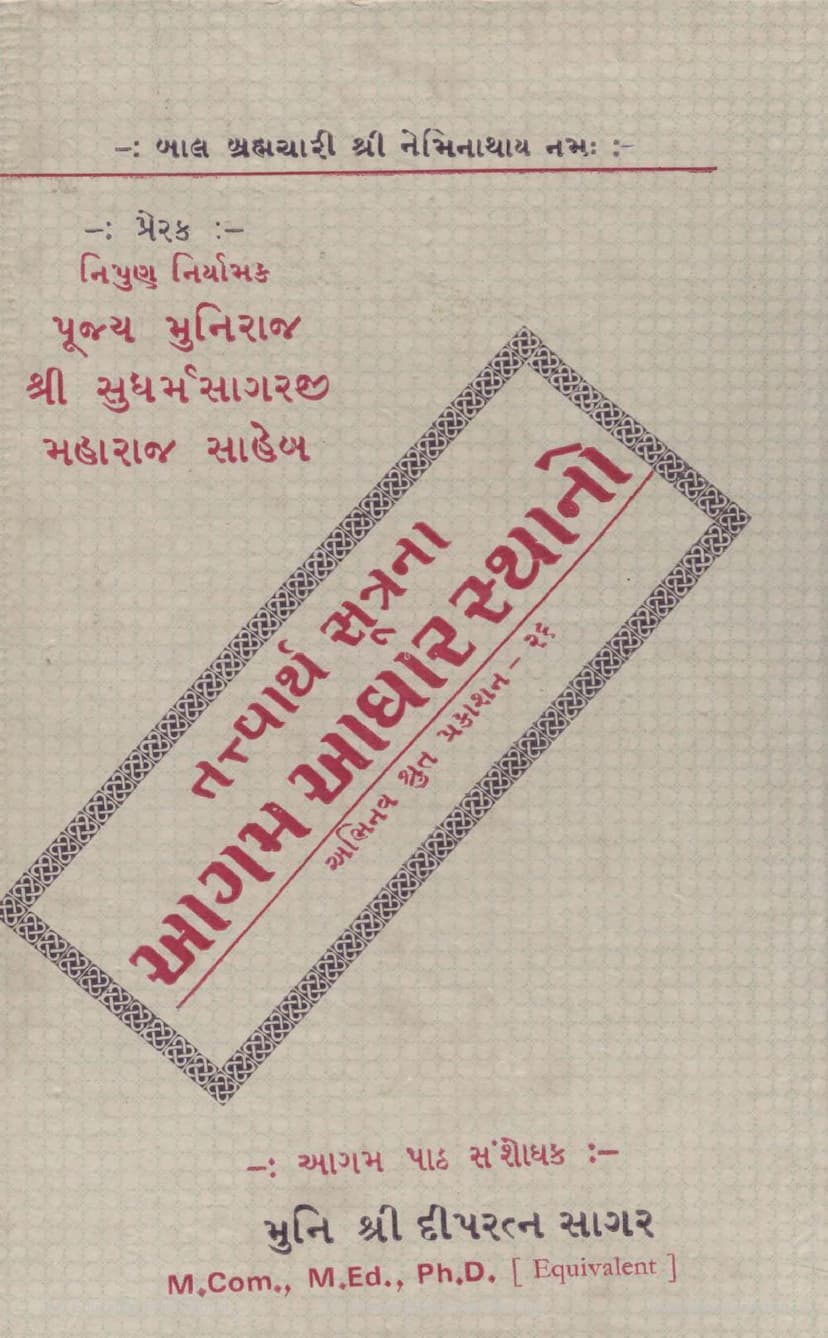Tattvartha Sutrana Agam Adhar Sthano
Added to library: September 2, 2025

Summary
This document is the Gujarati text of Tattvartha Sutrana Agam Adhar Sthano (Finding the Scriptural Basis for Tattvartha Sutra), authored by Muni Shri Deepratnasagar. It was published by Abhinav Shrut Prakashan, Ahmedabad.
Here's a comprehensive summary of its content based on the provided text:
Core Purpose:
The primary goal of this book is to meticulously identify and present the scriptural references (Agam Adhar Sthano) from the Jain Agamas that serve as the basis or support for each sutra in the Tattvartha Sutra. In essence, it aims to establish the scriptural lineage and validity of the Tattvartha Sutra by tracing its concepts back to the foundational Jain scriptures.
Key Features and Content:
-
Agam (Scriptural) Basis: The book systematically goes through each chapter and sutra of the Tattvartha Sutra. For every sutra, it provides the corresponding passage or reference from various Jain Agamas (scriptures). This is the central and most crucial aspect of the work.
-
Structure by Chapters of Tattvartha Sutra: The content is organized according to the 10 chapters of the Tattvartha Sutra, allowing for a chapter-by-chapter comparison of its sutras with their scriptural origins.
-
Identification of Source Agamas: The text explicitly mentions the names of the Agamas from which the references are drawn. Common Agamas cited include:
- Acharanga Sutra
- Sutrakritanga Sutra
- Sthana Sutra
- Samavaya Sutra
- Bhagavati Sutra
- Gnata Dharma Kathanga Sutra
- Upaasaka Dasanga Sutra
- Prashna Vyakarana Sutra
- Anuyoga Dwara Sutra
- Nandi Sutra
- Dashavaikalika Sutra
- Aupapatika Sutra
-
Detailed Sutra-by-Sutra Referencing: The book doesn't just provide chapter or section references; it often quotes specific sutras or passages from the Agamas, sometimes including the number of the sutra and its chapter.
-
Inclusion of Both Shvetambara and Digambara Perspectives: The publisher's note and appendices indicate an effort to include references that are valid or understood across both major Jain traditions (Shvetambara and Digambara), though the primary focus might be on establishing the scriptural basis from the broader scriptural canon recognized by both. Appendix 1 and 2 specifically discuss the differences in sutra counts and provides comparative textual references, highlighting the scholarly approach.
-
Scholarly Approach and Rigor: The author, Muni Shri Deepratnasagar, is presented as an accomplished scholar with qualifications like M.Com., M.Ed., and Ph.D. (Equivalent), suggesting a rigorous academic approach to the scriptural research. The introductory sections also speak of the challenges and meticulousness involved in this kind of textual research.
-
Purpose and Application: The publication aims to:
- Deepen understanding of the Tattvartha Sutra by showing its scriptural roots.
- Serve as a reference for scholars and practitioners interested in the scriptural basis of Jain philosophy.
- Aid in research and study related to the Tattvartha Sutra and the Agamas.
- Uphold the authenticity and authority of the Tattvartha Sutra by demonstrating its grounding in the ancient scriptures.
-
Appendices: The book includes appendices that are crucial for understanding its comparative nature:
- Appendix 1: Details the numerical differences in sutras between the Shvetambara and Digambara traditions for each chapter of Tattvartha Sutra, indicating a total of 13 more sutras in the Digambara tradition.
- Appendix 2: Discusses the types of differences found between the two traditions (numerical, conceptual, verbal, and arrangement) and lists specific sutras that are present in the Digambara tradition but not the Shvetambara, along with their available Agam references.
- Appendix 3: Provides a comparative table of sutras, highlighting where the Shvetambara and Digambara versions of the Tattvartha Sutra differ or where specific references might be found in one tradition's Agamas but not the other.
In Essence:
Tattvartha Sutrana Agam Adhar Sthano is a scholarly work that serves as a critical resource for understanding the scriptural foundation of the universally revered Jain text, the Tattvartha Sutra. It acts as a bridge between the Tattvartha Sutra and the vast corpus of ancient Jain Agamas, offering readers direct scriptural evidence for the principles propounded by Acharya Umaswati. The book reflects a deep commitment to textual accuracy and comparative scholarship within Jainism.